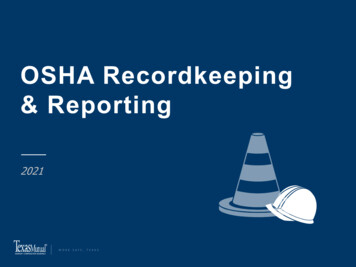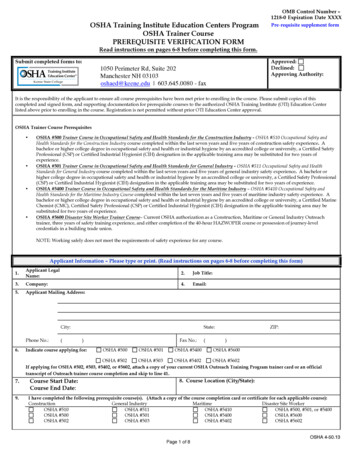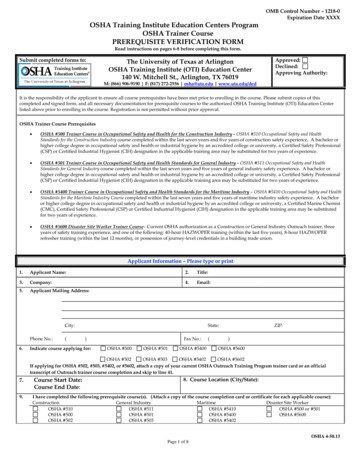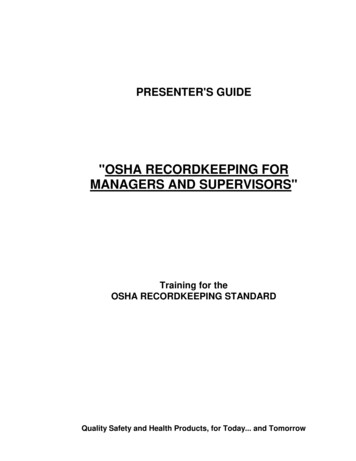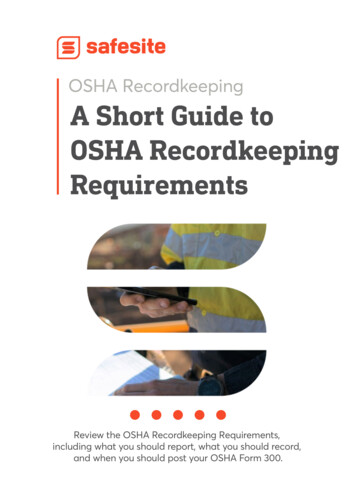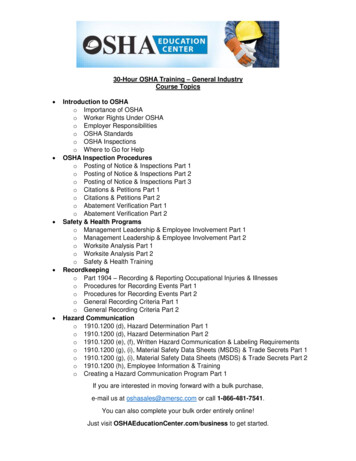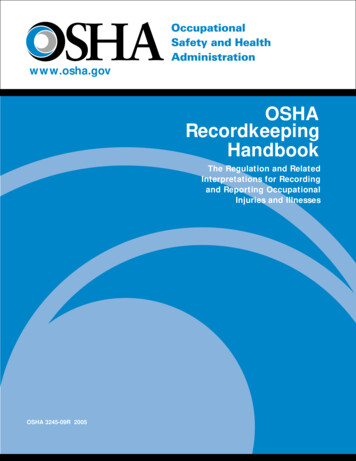
Transcription
OSHA Recordkeeping in the Healthcare Setting
Objectives1. Outline OSHA’s Recordkeeping Requirements for Hospitaland Healthcare Organizations2. Explain updated COVID-19 directives that impact theOSHA Recordkeeping Process3. Describe how to use OSHA Recordkeeping and other workaccident data in your Safety and Health ManagementProgram1
Brief History of the BLS & OSHA2
1940’s BLS (Bureau of Labor Statistics) begins collectingwork injury dataLimited in scope and voluntary for employers3
December 1970 – Occupational Safety and HealthAct (OSH Act) is signed into law by PresidentRichard NixonApril 28, 1971 OSHA is formed4
Purpose of OSHA“ .to assure safe and healthful working conditionsfor working men and women .”https://www.osha.gov/laws-regs/oshact/section 15
Purpose of OSHA Recordkeeping“The OSHA Recordkeeping system is intended to collect,compile and analyze uniform and consistent nationwidedata on occupational injuries and sha-3006
OSHA Injury & Illness RecordkeepingRule 29 CFR Part 19047
Sections of OSHA’s Recordkeeping RuleStandard Number - 1904Subpart A - PurposeSubpart B - ScopeSubpart C - Forms and recording criteriaSubpart D - Other requirementsSubpart E - Reporting to the governmentSubpart F - TransitionSubpart G - Definitions8
29 CFR Part 1904 - Subpart APurpose (of the Rule)To require employers to record and report work-relatedfatalities, injuries, and illnesses9
29 CFR Part 1904 - Subpart B - Scope1904.1 – Small employer partial exemptions If 10 or fewer employees at all times during the lastcalendar year1904.2 – Partially exempt industries If establishment classified in specific industry group, donot need to keep OSHA injury and illness records(see OSHA’s appendix A to 1904 Subpart B for a complete list of partially exempt industry standardnumber/1904/1904.210
Partially Exempt Healthcare related IndustriesSome examples of partially exempt healthcare relatedindustries1. Offices of Physicians2. Offices of Dentists3. Offices of Other Health Practitioners4. Outpatient Care Centers5. Medical and Diagnostic Laboratories11
Covered Healthcare IndustriesThat Must Record Injuries and Illnesses1.2.3.4.General Medical & Surgical HospitalsPsychiatric and Substance Abuse HospitalsSpecialty (except Psychiatric and Abuse) HospitalsNursing Care Facilities (Skilled Nursing Facilities)12
29 CFR Part 1904 - Subpart CRECORDKEEPING FORMS & RECORDING CRITERIAMust record all new cases of work related fatalities,injuries, and illnesses that meet one or more of thecriteria contained in sections 1904.7 through 1904.11.13
14
General Recording Criteria1904.7Injuries or Illness that involve one or more of the followingmust be recorded on the OSHA 300 Log DeathDays away from workRestricted Work or Job TransferMedical Treatment beyond first aidLoss of consciousnessOther significant injuries or illnesses15
Days Away Cases1904.7(b)(3)Record if the case involves one or more days away fromwork (excluding day of injury or illness)Check the box for days away cases and count the numberof calendar days16
Days Away Cases1904.7(b)(3) (continued) Cap day count at 180 days away and/or days restricted May stop day count if employee leaves company for areason unrelated to the injury or illness17
Restricted Work Cases1904.7(b)(4)Record if the case involves one or more days of restrictedwork or job transfer (excluding day of injury or illness)Check the box for restricted/transfer cases and count thenumber of days18
Restricted Work Cases1904.7(b)(4) (continued)Restricted work means the employees is: Unable to work the full workday he or she wouldotherwise have been scheduled to work; or Unable to perform one or more routine job functionsRoutine Job Functions: those activities the employeeregularly performs at least once per week19
Job Transfer1904.7(b)(4)Definition of Job transferAn injured or ill employee is assigned to a job other thanhis or her regular job for part of the dayA case is recordable if the injured or ill employee performshis or her routine job duties for part of a day and isassigned to another job for the rest of the day20
Medical Treatment1904.7(b)(5)(i)Definition of Medical Treatment“The management and care of a patient to combatdisease or disorder.”21
Medical Treatment1904.7(b)(5)(i)(A) & (B)Medical Treatment DOES NOT include: Visits to Medical Provider solely for observation orcounseling Diagnostic procedures22
What is “First Aid”1904.7(b)(5)(ii) Using nonprescription medication at nonprescriptionstrength Tetanus immunizations Cleaning, flushing, or soaking surface wounds Wound coverings, butterfly bandages, Steri-Strips Hot or cold therapy Non-rigid means of support Temporary immobilization device used to transportaccident victims23
First Aid (continued)1904.7(b)(5) Drilling of fingernail or toenail, draining fluid from blister Eye patches Removing foreign bodies from eye using irrigation orcotton swab Removing splinters or foreign material from areas otherthan the eye by irrigation, tweezers, cotton swabs orother simple means Finger guards Massages Drinking fluids for relief of heat stress24
Classifying the Injury and Type of IllnessColumn (M) - OSHA 300 LogDefinition of “Injury”Any wound or damage to the body resulting from an event in the workenvironment. Cut, puncture, laceration, abrasion, fracture, bruise,amputation, insect bite, electrocution, or a thermal, chemical,electrical, or radiation burn. Sprain and strain injuries to muscles,joints, and connective tissues are classified as injuries when theyresult from a slip, trip, fall or other similar rkforms-winstr fillable.pdf25
Classifying the Injury and Type of IllnessColumn (M) - OSHA 300 LogIllness Type: Skin diseases or disorders are illnesses involving theworker’s skin that are caused by work exposure to chemicals,plants, or other -rkforms-winstr fillable.pdf26
Classifying the Injury and Type of IllnessColumn (M) - OSHA 300 LogIllness Type: Respiratory conditions are illnesses associated withbreathing hazardous biological agents, chemicals, dust, gases,vapors, or fumes at ms-winstr fillable.pdf27
Classifying the Injury and Type of IllnessColumn (M) - OSHA 300 LogIllness Type: Poisoning includes disorders evidenced by abnormalconcentrations of toxic substances in blood, other tissues, otherbodily fluids, or the breath that are caused by the ingestion orabsorption of toxic substances into the ms-winstr fillable.pdf28
Classifying the Injury and Type of IllnessColumn (M) - OSHA 300 LogIllness Type: Severity Type: Hearing Loss is noise-induced hearingloss as defined for recordkeeping purposes as a change in g/osha-rkforms-winstr fillable.pdf29
Classifying the Injury and Type of IllnessColumn (M) - OSHA 300 LogIllness Type: All other illnesses include heatstroke, sunstroke, heatexhaustion, heat stress and other effects of environmental heat;effects of ionizing radiation (isotopes, x-rays, radium); effects ofnonionizing radiation (welding flash, ultra-violet rays, lasers);anthrax; blood borne pathogenic diseases, such as AIDS, HIV,Hepatitis B or Hepatitis C; brucellosis; malignant or benign tumors;histoplasmosis; ing/osha-rkforms-winstr fillable.pdf30
Loss of Consciousness1904.7(b)(6)All work-related cases involving loss of consciousnessmust be recorded31
Significant Diagnosed Injury or Illness1904.7(b)(7)Always record the following work related conditions:(even if no treatment rendered) CancerChronic irreversible diseasePunctured eardrumFractured or cracked bone or tooth32
Recording Criteria for Needlesticksand sharps injuries - 1904.8All work-related “contaminated sharps” i.e. needlesticksand cuts from sharp objects that are contaminated withanother person’s blood or OPIM must be recorded onthe OSHA 300 LogOPIM Other Potentially Infectious Material33
Non-Sharps Recording Criteria - 1904.8(b)(4)Only record work-related splashes or “non-sharp” relatedexposures to blood or OPIM if it results in a diagnosisof a bloodborne disease or meets the generalrecording criteria34
Medical Removal1904.9 Work Exposures in which an employee is medicallyremoved under the medical surveillance requirements ofan OSHA standard, must be recorded on the OSHA 300Log.Examples: Lead, cadmium, methylene chloride,formaldehyde, benzene etc.35
Hearing Loss1904.10Must record all work-related hearing loss cases where: An employee’s hearing test (audiogram) demonstrates theyhave experienced a work-related Standard Threshold Shift(STS) in hearing in one or both ears, and the total hearinglevel is 25 decibels (dB) or more above audiometric zero(averaged at 2000, 3000, and 4000 Hz) in the same earsas the STS.See OSHA Standard Number 1904.10 for complete details36
Tuberculosis1904.11Work related exposures to someone with a known case ofactive TB that develops into a TB infection must berecorded on the OSHA Log.37
OSHA 300 Log & 301 Form1904.29(b)(3) Record case in log and complete OSHA 301 formwithin 7 calendar days of receiving information.38
OSHA Form 301Injury and Illness Incident Report39
OSHA 300 Log & 301 Form1904.29(b)(3) continued Forms that have all of the same information that is onthe OSHA 301 Form may be usedExample: work accident or incident reports40
OSHA 300 Log & 301 Form1904.29(b)(3) continued Computer records are permitted if they can be produced when needed41
OSHA Log - Privacy Concern Cases1904.29(b)(6) Do not enter the name of an employee on the OSHA 300Log for “privacy concern cases” Enter “privacy case” in the name column Keep a separate confidential list of the case numbersand employee names42
Privacy Case Determination1904.29(b)(7)Privacy concern cases are: Injuries or illnesses to an intimate body part orreproductive system Injury or illness from a sexual assault Mental illness43
Privacy Case Determination1904.29(b)(7) continuedPrivacy concern cases are: HIV infection, hepatitis, tuberculosis Needlestick or sharps injuries contaminated with anotherperson’s blood or OPIM Employee requests to keep their name off44
Sharps Injury Log29 CFR 1910.103045
Sharps Injury Log29 CFR 1910.1030 Must establish and maintain a sharps injury log recordingof percutaneous injuries from contaminated sharps Must be recorded in such manner as to protect theconfidentiality of the injured employee46
Sharps Injury Log29 CFR 1910.1030Minimum information that should be on the log(A) The type and brand of device involved in the incident,(B) The department or work area where the exposureincident occurred, and(C) An explanation of how the incident occurred.47
29 CFR Part 1904 - Subpart DOther OSHA Injury & Illness RecordkeepingRequirements 1904.30 – Multiple business establishments1904.31 – Covered employees1904.32 – Annual summary1904.33 – Retention and updating1904.34 – Change in business ownership1904.35 – Employee involvement1904.36 – Prohibition against discrimination1904.37 – State recordkeeping regulations1904.38 – Variances from the recordkeeping rule48
Multiple Business Establishments1904.30OSHA Recordkeeping for: Hospital Other Locations Hospital or Health System Employees working atmultiple locations49
Covered Employees1904.31The following employees are to be recorded on theOSHA 300 Log All employees on your payroll Temp Employees you supervise on a day-to-day basisi.e. Agency RN, CNA, etc. Contractor employees you supervise on a day-to-daybasis50
Annual Summary of Work-RelatedInjuries and Illnesses - OSHA 300A - 1904.3251
Annual Summary of Work-RelatedInjuries and Illnesses - OSHA 300A - 1904.32At the end of each calendar year you must prepare andpost form OSHA 300A.52
Annual Summary of Work-RelatedInjuries and Illnesses - OSHA 300A (continued) Review & Update OSHA 300 Log to verify that theentries are complete and accurate53
Annual Summary of Work-RelatedInjuries and Illnesses - OSHA 300A (continued) Create annual summary of injuries and illnesses usingthe OSHA 300A form and data from the OSHA 300 Log54
Annual Summary of Work-RelatedInjuries and Illnesses - OSHA 300A (continued) Establishment Name Industry Description NAICS number (located on the BLS Survey Form)55
Annual Summary of Work-RelatedInjuries and Illnesses - OSHA 300A (continued) Annual average number of employees Total hours worked by all employees56
Annual Summary of Work-RelatedInjuries and Illnesses - OSHA 300A (continued)Annual average number of employees calculation57
Annual Summary of Work-RelatedInjuries and Illnesses - OSHA 300A (continued)Annual average number of employees calculationExample58
Annual Summary of Work-RelatedInjuries and Illnesses - OSHA 300A (continued) Certify the annual summary59
Annual Summary of InjuriesOSHA 300A - 1904.32Company Executive who signs the form can be: An Officer of the hospital or health system i.e. CEO,Compliance Officer The Highest ranking company official of the hospital orhealth system60
Annual Summary of InjuriesOSHA 300A - 1904.32 Post Annual Summary no later than February 1stWhere should it be posted? “conspicuous place or places where notices toemployees are customarily posted.”61
Annual Summary of InjuriesOSHA 300A - 1904.32Mandatory Posting PeriodThe Annual Summary of Injuries must be posted betweenFebruary 1st and April 30th62
Retention & Updating1904.335 Year Retention RequirementYou MUST keep ALL OSHA Recordkeeping Records(5) years following the end of the calendar year that theserecords cover.63
Retention & Updating (continued)1904.33Updating the OSHA 300 Logduring five-year storage periodHospitals/Health Systems MUST UPDATE storedOSHA 300 Logs documenting new cases and change incase status.64
Retention & Updating (continued)1904.33 You DO NOT have to update the OSHA 300A AnnualSummary Form or OSHA 301 Incident Reports.65
Subpart E - Reporting Information to theGovernment1904.39 Fatality and catastrophe reporting1904.40 Access for Government representatives1904.41 OSHA Survey1904.42 BLS Survey66
Reporting Fatalities and Severe Injuries1904.39*****Important OSHA Reporting Condition***** Fatality Reporting: “only if fatality occurs within(30) days of the work-related incident.” 1904.39(b)(6) In-Patient Hospitalization: “only if it occurs within(24) hours of the work-related incident.” 1904.39(b)(6)67
Reporting Fatalities and Severe Injuries1904.3968
Electronic Submission of Injury and IllnessSummary to OSHA – 1904.41DeadlineSubmission must be made by March 2 of each year69
Electronic Submission of Injury and IllnessSummary to OSHA – (continued)Which healthcare organizations must submit records? Establishments with 250 or more employees that arerequired to keep OSHA Injury & Illness Records Establishments with 20-249 employees that areclassified in certain industries70
Electronic Submission of Injury and IllnessSummary to OSHA – (continued)Data submission processOSHA provides a secure website where employers createan account, enter, and submit their data.https://www.osha.gov/injuryreporting/ita/71
BLS Survey of Occupational Injuries andIllnesses - 1904.42Basic requirement. If you receive a Survey ofOccupational Injuries and Illnesses Form from the Bureauof Labor Statistics (BLS), or a BLS designee, you mustpromptly complete the form and return it following theinstructions contained on the survey form.72
COVID-19 CasesOSHA Recordkeeping DirectivesCriteria to Record COVID-19 Cases on OSHA 300 Log Confirmed case of COVID-19 as defined by the CDC Case is work related as defined by 29 CFR §1904.5 Case involves one or more general recording criteria setfor in 29 CFR §1904.773
COVID-19 Type of Injury or IllnessPursuant to the May 19, 2020 Memo from OSHA“COVID-19 is a respiratory illness and should be coded assuch on the OSHA Form 300.”74
COVID-19 CasesOSHA Reporting DirectivesOSHA’s COVID-19 Emergency Temporary Standard (ETS)requires employers to report all work-related COVID-19fatalities and in-patient hospitalizations to OSHA. Fatality (report within 8hrs of notice) Inpatient Hospitalizations (report within 24hrs of notice) Under ETS NO LIMITS on when exposure occurred75
COVID-19 Log – 1910.50276
COVID-19 Log (continued) Employers covered under the COVID-19 ETS mustestablish and maintain a COVID-19 Log The log must record each instance identified by theemployer in which an employee is COVID-19 positiveregardless of whether it is from an exposure at work ons/OSHA4130.pdf77
OSHA Recordkeeping &Hospital Safety and Health Management Systems78
Hazard Identification and AssessmentTable 2-1. Examples of Information Sources for HazardIdentification and AssessmentOne of the sources listed are Workplace injury and illnessinformation including the OSHA Recordkeeping forms.79
OSHA 300 Log Safety InformationProvides the opportunity to identify:1. Hazards that caused the most incidents2. Occupations with the most incidents3. Departments with the most incidents and types ofincidents4. Incidents and hazards resulting in the most severeoutcomes80
OSHA 300A and BenchmarkingThe information collected by the BLS is available to reviewfor benchmarking purposes.81
Benchmarking Rate DefinitionsTotal Incidence Rate Total recordable injury & illnesscasesDays Away Rate Cases involving days away from workJob Transfer/Restriction Rate Cases involving job transferor restricted work activity onlyDART Rate Total cases involving days away from work,days of restricted work activity, and/or job transfer82
OSHA 300A and BenchmarkingExample of a result using the BLS Injury and Illness RateCalculator and Comparison Tool for General Medical andSurgical Hospitals (NAICS 622100).83
HOSPITAL BENCHMARKING EXAMPLE84
QUESTIONS?Please email all questions to Mike Benedeck atmbenedeck@team-iha.orgOSHA Recordkeeping and other presentation resourcelinks will be emailed to all participants85
For More HelpFor any OSHA Recordkeeping assistance neededContact the IRMS/ICT Loss Control Department.Mike Benedeck – Senior Director of Loss Controlmbenedeck@team-iha.org (630) 276-5646Deidre Harris – Senior Loss Control Specialistdharris@team-iha.org (630) 276-541486
Outline OSHA's Recordkeeping Requirements for Hospital and Healthcare Organizations 2. Explain updated COVID-19 directives that impact the OSHA Recordkeeping Process 3. Describe how to use OSHA Recordkeeping and other work accident data in your Safety and Health Management
